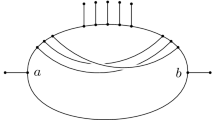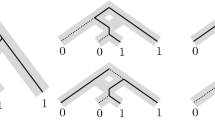Abstract
Here we show that, given a set of clusters \({\mathcal{C}}\) on a set of taxa \({\mathcal{X}}\), where \(|{\mathcal{X}}|=n\), it is possible to determine in time f(k)⋅poly(n) whether there exists a level-≤k network (i.e. a network where each biconnected component has reticulation number at most k) that represents all the clusters in \({\mathcal{C}}\) in the softwired sense, and if so to construct such a network. This extends a result from Kelk et al. (in IEEE/ACM Trans. Comput. Biol. Bioinform. 9:517–534, 2012) which showed that the problem is polynomial-time solvable for fixed k. By defining “k-reticulation generators” analogous to “level-k generators”, we then extend this fixed parameter tractability result to the problem where k refers not to the level but to the reticulation number of the whole network.









Similar content being viewed by others
Notes
This is the definition when all reticulation vertices have indegree-2, for more general networks reticulation number is defined slightly differently. See the Preliminaries for more information.
Alternatively, we say that a network N represents a cluster \(C \subset \mathcal{X}\) “in the hardwired sense” if there exists a tree edge (u,v) of N such that C is the set of leaf descendants of v.
Otherwise \({\mathcal{C}}\) can be trivially represented by the star tree on \({\mathcal{X}}\).
Note that to determine the reticulation number of a biconnected component, the indegree of each node is computed using only edges belonging to this biconnected component.
Recall that, by Lemma 1 of [20], the existence of a level-k network representing a separating set of clusters \({\mathcal{C}}\) on \({\mathcal{X}}\) implies that a simple level-k network representing \({\mathcal{C}}\) has to exist.
Note that the number of level-k generators grows rapidly in k, lying between 2k−1 and k!250k [8].
References
Bordewich, M., Semple, C.: Computing the hybridization number of two phylogenetic trees is fixed-parameter tractable. IEEE/ACM Trans. Comput. Biol. Bioinf. 4(3), 458–466 (2007)
Bordewich, M., Semple, C.: Computing the minimum number of hybridization events for a consistent evolutionary history. Discrete Appl. Math. 155(8), 914–928 (2007)
Bordewich, M., Linz, S., John, K.St., Semple, C.: A reduction algorithm for computing the hybridization number of two trees. Evol. Bioinform. 3, 86–98 (2007)
Chen, Z.-Z., Wang, L.: Algorithms for reticulate networks of multiple phylogenetic trees. IEEE/ACM Trans. Comput. Biol. Bioinform. 9, 372–384 (2012)
Collins, J., Linz, S., Semple, C.: Quantifying hybridization in realistic time. J. Comput. Biol. 18(10), 1305–1318 (2011)
Downey, R.G., Fellows, M.R.: Parameterized Complexity. Springer, Berlin (1999)
Flum, J., Grohe, M.: Parameterized Complexity Theory. Springer, Berlin (2006)
Gambette, P., Berry, V., Paul, C.: The structure of level-k phylogenetic networks. In: Proceedings of the 20th Annual Symposium on Combinatorial Pattern Matching, CPM ’09, pp. 289–300. Springer, Berlin (2009)
Gascuel, O. (ed.): Mathematics of Evolution and Phylogeny. Oxford University Press, Oxford (2005)
Gascuel, O., Steel, M. (eds.): Reconstructing Evolution: New Mathematical and Computational Advances. Oxford University Press, Oxford (2007)
Gramm, J., Nickelsen, A., Tantau, T.: Fixed-parameter algorithms in phylogenetics. Comput. J. 51(1), 79–101 (2008)
Gusfield, D., Bansal, V., Bafna, V., Song, Y.: A decomposition theory for phylogenetic networks and incompatible characters. J. Comput. Biol. 14(10), 1247–1272 (2007)
Gusfield, D., Hickerson, D., Eddhu, S.: An efficiently computed lower bound on the number of recombinations in phylognetic networks: theory and empirical study. Discrete Appl. Math. 155(6–7), 806–830 (2007)
Huson, D.H., Scornavacca, C.: A survey of combinatorial methods for phylogenetic networks. Genome Biol. Evol. 3, 23–35 (2011)
Huson, D.H., Rupp, R., Berry, V., Gambette, P., Paul, C.: Computing galled networks from real data. Bioinformatics 25(12), i85–i93 (2009)
Huson, D.H., Rupp, R., Scornavacca, C.: Phylogenetic Networks: Concepts, Algorithms and Applications. Cambridge University Press, Cambridge (2011)
Huynh, T.N.D., Jansson, J., Nguyen, N.B., Sung, W.-K.: Constructing a smallest refining galled phylogenetic network. In: Research in Computational Molecular Biology (RECOMB). Lecture Notes in Bioinformatics, vol. 3500, pp. 265–280 (2005)
Jansson, J., Sung, W.-K.: Inferring a level-1 phylogenetic network from a dense set of rooted triplets. Theor. Comput. Sci. 363(1), 60–68 (2006)
Jansson, J., Nguyen, N.B., Sung, W.-K.: Algorithms for combining rooted triplets into a galled phylogenetic network. SIAM J. Comput. 35(5), 1098–1121 (2006)
Kelk, S., Scornavacca, C., van Iersel, L.: On the elusiveness of clusters. IEEE/ACM Trans. Comput. Biol. Bioinform. 9, 517–534 (2012)
Myers, S.R., Griffiths, R.C.: Bounds on the minimum number of recombination events in a sample history. Genetics 163, 375–394 (2003)
Nakhleh, L.: Evolutionary phylogenetic networks: models and issues. In: The Problem Solving Handbook for Computational Biology and Bioinformatics. Springer, Berlin (2009)
Niedermeier, R.: Invitation to Fixed Parameter Algorithms. Oxford Lecture Series in Mathematics and Its Applications. Oxford University Press, Oxford (2006)
Semple, C.: Hybridization networks. In: Reconstructing Evolution—New Mathematical and Computational Advances. Oxford University Press, Oxford (2007)
Semple, C., Steel, M.: Phylogenetics. Oxford University Press, Oxford (2003)
To, T.-H., Habib, M.: Level-k phylogenetic networks are constructable from a dense triplet set in polynomial time. In: CPM09. LNCS, vol. 5577, pp. 275–288 (2009)
van Iersel, L., Kelk, S.: Constructing the simplest possible phylogenetic network from triplets. Algorithmica 60, 207–235 (2011)
van Iersel, L.J.J., Kelk, S.M.: When two trees go to war. J. Theor. Biol. 269(1), 245–255 (2011)
van Iersel, L.J.J., Keijsper, J.C.M., Kelk, S.M., Stougie, L., Hagen, F., Boekhout, T.: Constructing level-2 phylogenetic networks from triplets. IEEE/ACM Trans. Comput. Biol. Bioinform. 6(4), 667–681 (2009)
van Iersel, L.J.J., Kelk, S.M., Mnich, M.: Uniqueness, intractability and exact algorithms: reflections on level-k phylogenetic networks. J. Bioinform. Comput. Biol. 7(2), 597–623 (2009)
van Iersel, L.J.J., Kelk, S.M., Rupp, R., Huson, D.H.: Phylogenetic networks do not need to be complex: Using fewer reticulations to represent conflicting clusters. Bioinformatics 26, i124–i131 (2010). Special issue: Proceedings of Intelligent Systems for Molecular Biology 2010 (ISMB2010), 10th–13th September (2010)
Whidden, C., Zeh, N.: A unifying view on approximation and fpt of agreement forests. In: Salzberg, S., Warnow, T. (eds.) Algorithms in Bioinformatics. Lecture Notes in Computer Science, vol. 5724, pp. 390–402. Springer, Berlin (2009)
Whidden, C., Beiko, R.G., Zeh, N.: Fixed-parameter and approximation algorithms for maximum agreement forests. arXiv:1108.2664v1 [q-bio.PE]
Wu, Y.: Close lower and upper bounds for the minimum reticulate network of multiple phylogenetic trees. Bioinformatics 26, i140–i148 (2010). Special issue: Proceedings of Intelligent Systems for Molecular Biology 2010 (ISMB2010), 10th–13th September (2010)
Wu, Y., Gusfield, D.: A new recombination lower bound and the minimum perfect phylogenetic forest problem. J. Comb. Optim. 16(3), 229–247 (2008)
Author information
Authors and Affiliations
Corresponding author
Rights and permissions
About this article
Cite this article
Kelk, S., Scornavacca, C. Constructing Minimal Phylogenetic Networks from Softwired Clusters is Fixed Parameter Tractable. Algorithmica 68, 886–915 (2014). https://doi.org/10.1007/s00453-012-9708-5
Received:
Accepted:
Published:
Issue Date:
DOI: https://doi.org/10.1007/s00453-012-9708-5




